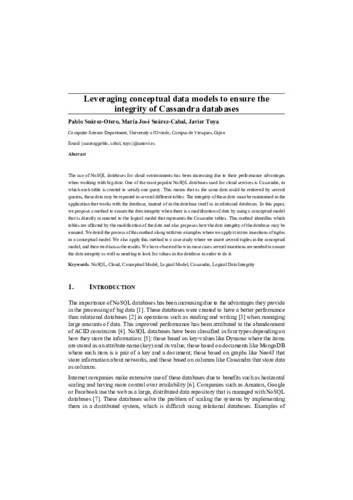Leveraging conceptual data models to ensure the integrity of Cassandra databases
Autor(es) y otros:
Palabra(s) clave:
NoSQL
Cloud
Conceptual Model
Logical Model
Cassandra
Logical Data Integrity
Fecha de publicación:
Editorial:
River Publishers
Versión del editor:
Citación:
Descripción física:
Resumen:
The use of NoSQL databases for cloud environments has been increasing due to their performance advantages when working with big data. One of the most popular NoSQL databases used for cloud services is Cassandra, in which each table is created to satisfy one query. This means that as the same data could be retrieved by several queries, these data may be repeated in several different tables. The integrity of these data must be maintained in the application that works with the database, instead of in the database itself as in relational databases. In this paper, we propose a method to ensure the data integrity when there is a modification of data by using a conceptual model that is directly connected to the logical model that represents the Cassandra tables. This method identifies which tables are affected by the modification of the data and also proposes how the data integrity of the database may be ensured. We detail the process of this method along with two examples where we apply it in two insertions of tuples in a conceptual model. We also apply this method to a case study where we insert several tuples in the conceptual model, and then we discuss the results. We have observed how in most cases several insertions are needed to ensure the data integrity as well as needing to look for values in the database in order to do it.
The use of NoSQL databases for cloud environments has been increasing due to their performance advantages when working with big data. One of the most popular NoSQL databases used for cloud services is Cassandra, in which each table is created to satisfy one query. This means that as the same data could be retrieved by several queries, these data may be repeated in several different tables. The integrity of these data must be maintained in the application that works with the database, instead of in the database itself as in relational databases. In this paper, we propose a method to ensure the data integrity when there is a modification of data by using a conceptual model that is directly connected to the logical model that represents the Cassandra tables. This method identifies which tables are affected by the modification of the data and also proposes how the data integrity of the database may be ensured. We detail the process of this method along with two examples where we apply it in two insertions of tuples in a conceptual model. We also apply this method to a case study where we insert several tuples in the conceptual model, and then we discuss the results. We have observed how in most cases several insertions are needed to ensure the data integrity as well as needing to look for values in the database in order to do it.
Patrocinado por:
Ministry of Economy and Competitiveness
This work was supported by the TESTEAMOS project (MINECO-17-TIN2016-76956-C3-1-R) and the PERTEST project (MINECO-13-TIN2013-46928-C3-1-R) of the Ministry of Economy and Competitiveness, Spain. It has also been supported by the project GRUPIN14-007 of the Principality of Asturias and by the ERDF.
Colecciones
- Artículos [37538]
- Informática [875]
- Investigaciones y Documentos OpenAIRE [8403]
Ficheros en el ítem





